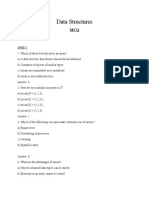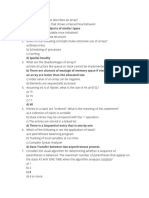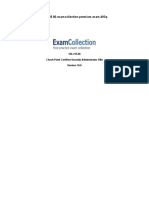Data Structure and Algorithms
Uploaded by
samir pramanikData Structure and Algorithms
Uploaded by
samir pramanikCamellia Institute of Technology
ASSIGNMENT FOR CA3
Stream: CSE Sem.: 3rd AY: 2022-23
Paper Code: PCC-CS301 Paper Name: Data Structure and Algorithms
GROUP A (MCQ) (Each question carries 1 mark)
1. i) Which if the following is/are the levels of implementation of data structure?
A. Abstract level B. Application level C. Implementation level D. All of the above
ii) Array passed as an argument to a function is interpreted as
A. Address of the array B. Values of the first elements of the array
C. Address of the first element of the array D. Number of element of the array
iii) Which of the following data structures are indexed structures?
A. Linear arrays B. Linked lists C. Graphs D. Trees
iv) Which data structure is a pile in which items are added at one end and removed from the other?
A. Stack B. Queue C. List D. None of the above
v) When does top value of the stack changes?
A. Before deletion B. While checking underflow C. At the time of deletion D. After deletion
vi) The postfix form of the expression (A+ B)*(C*D- E)*F / G is?
A. AB + CD*E - FG /** B. AB + CD* E - **FG /
C. AB + CD* E - *FG */ D. AB + CDE * - * F *G /
vii) A circular queue is implemented using an array of size 10. The array index starts with 0, front is 6, and rear is 9.The
insertion of next element takes place at the array index.
A. 7 B. 0 C. 9 D. 10
viii) The result of evaluating the postfix expression 5, 4, 6, +, *, 4, 9, 3, /, +, * is?
A. 600 B. 350 C. 650 D. 588
ix) What will be the maximum value of top, if there is a size of stack MAXSIZE is 5
A. 5 B. 4 C. 6 D. None of the above
x) Which of the following sorting algorithms can be used to sort a random linked list with minimum time complexity?
a) Insertion Sort b) Quick Sort c) Heap Sort d) Merge Sort
xi) In the worst case, the number of comparisons needed to search a singly linked list of length n for a given element is?
a) log 2 n b) n⁄2 c) log 2 n – 1 d) n
xi) Linked list are not suitable for
a) Insertion Sort b) Binary Search c) Radix Sort d) Polynomial Manipulation
xii) Inserting a new node after a given node in a doubly linked list requires
a) 2 pointers exchange b) no pointer exchange c) 4 pointers exchange d) 1 pointer exchange
xiii)The complexity of merge sort algorithm is
a) O(n) b) O(n2) c) O(nlogn) d) O(logn)
xiv) The worst case of quick sort algorithm is
a) O(n) b) O(n2) c) O(nlogn) d) O(logn)
GROUP B (Each question carries 5 marks)
2. What is Linked list? What are the advantages and disadvantages of linked list over an array? [2+3]
Ans: A linked list is a linear data structure, in which the elements are not stored at [5]
contiguous memory locations. The elements in a linked list are linked using pointers.
[2+3]
3. Write a C function to insert a node with specified value at the end of a singly linked list.
[4+1]
4. Define the ADT for Stack. Write the algorithm for Push and Pop operation in Stack.
5. Write a C function for selection sort and also calculate the time complexity for selection
sort.
[5]
[2+3]
[1+4]
[5]
6. Convert the following infix expression to postfix notation by showing the operator stack and output string [5]
after
reading each input token:
A * (B + D) / E - F * (G + H / K) ^ X
7. What is queue? What is the advantage of circular queue over queue?
8. What is circular queue? Write Q-insert algorithm for the circular queue.
[5]
9. Insert the following numbers into Max heap and Min heap:
[5]
39, 89 , 12 , 67 , 56 , 43 , 54 , 98 , 6 , 60 , 95 , 26
10. Sort the following array with explanation using quick sort method:
24 , 56 ,47 ,35 ,10 ,90 ,82 ,31, 67, 8, 76
Analyse its time complexity.
11. Convert the following infix expression to postfix expression by showing the operator stack and output string after
reading each input token:
A * B + C * ( D – E) – F / G
12. Write the algorithm and explain Binary Search with a suitable example.
Note: a stack is a particular kind of abstract data type or collection in which the principal (or only) operations on the
collection are the addition of an entity to the collection, known as push and removal of an entity, known as pop. The
relation between the push and pop operations is such that the stack is a Last-In-First-Out (LIFO) data structure. In a
LIFO data structure, the last element added to the structure must be the first one to be removed. This is equivalent to the
requirement that, considered as a linear data structure, or more abstractly a sequential collection, the push and pop
operations occur only at one end of the structure, referred to as the top of the stack.
You might also like
- Vmware Vsphere Install Configure Manage v8 - Mericler 2024No ratings yetVmware Vsphere Install Configure Manage v8 - Mericler 2024146 pages
- Compiler Design Multiple Choice Questions Answers PDF100% (2)Compiler Design Multiple Choice Questions Answers PDF3 pages
- Unit Iii Linear Data Structures: SyllabusNo ratings yetUnit Iii Linear Data Structures: Syllabus19 pages
- Data Structure Multiple Choice Questions - Admissionadda67% (3)Data Structure Multiple Choice Questions - Admissionadda13 pages
- Data Structure Questions and Answers - Stack Operations - 1: Prev Next50% (2)Data Structure Questions and Answers - Stack Operations - 1: Prev Next10 pages
- Event-Driven Programming MCQ Worksheet For Exit Exam 2015@No ratings yetEvent-Driven Programming MCQ Worksheet For Exit Exam 2015@10 pages
- C Programming: Cloud IT Online Practices ProblemNo ratings yetC Programming: Cloud IT Online Practices Problem24 pages
- Cs 503 - Design & Analysis of Algorithm: Multiple Choice QuestionsNo ratings yetCs 503 - Design & Analysis of Algorithm: Multiple Choice Questions3 pages
- 100 Top Data Structures and Algorithms Multiple Choice Questions and Answers100% (1)100 Top Data Structures and Algorithms Multiple Choice Questions and Answers22 pages
- Database Management System: Multiple Choice Questions & Answers100% (1)Database Management System: Multiple Choice Questions & Answers7 pages
- Algorithms Design and Analysis Mcqs With Answers Set 160% (5)Algorithms Design and Analysis Mcqs With Answers Set 110 pages
- Public Class Array (Public Static Void Main (String Args ) (Int Arr (1,2,3,4,5) System - Out.println (Arr (2) ) System - Out.println (Arr (4) ) ) )No ratings yetPublic Class Array (Public Static Void Main (String Args ) (Int Arr (1,2,3,4,5) System - Out.println (Arr (2) ) System - Out.println (Arr (4) ) ) )5 pages
- 7000+ Internet Programming Questions and Answers PDF - 1No ratings yet7000+ Internet Programming Questions and Answers PDF - 11 page
- The Second Round of National Exit Exam Questions (1-45)100% (3)The Second Round of National Exit Exam Questions (1-45)10 pages
- Multiple Choice Questions On Operating System Part100% (3)Multiple Choice Questions On Operating System Part24 pages
- Exit Exam Fundamentals of Database System 1 3No ratings yetExit Exam Fundamentals of Database System 1 35 pages
- Operating System Module Only For Exit Exam Preparation DawitNo ratings yetOperating System Module Only For Exit Exam Preparation Dawit29 pages
- Fundamentals of Data Structures - MCQ - III.100% (1)Fundamentals of Data Structures - MCQ - III.22 pages
- Fundamentals of Data Structures - MCQ - II100% (1)Fundamentals of Data Structures - MCQ - II34 pages
- Computer Science CS/CIS/CN Major Exit Exam Study Guide100% (1)Computer Science CS/CIS/CN Major Exit Exam Study Guide2 pages
- System Analysis Design MCQ Worksheet For Exit Exam 2015@100% (4)System Analysis Design MCQ Worksheet For Exit Exam 2015@20 pages
- DS-KH6320-WTPE2 Video Intercom Two-Wire Indoor Station: Key FeatureNo ratings yetDS-KH6320-WTPE2 Video Intercom Two-Wire Indoor Station: Key Feature3 pages
- Course Formal Assertion Based Verification Session Formal Model Checking MeslingerNo ratings yetCourse Formal Assertion Based Verification Session Formal Model Checking Meslinger29 pages
- 50.atm Security System Using GSM& Mems TechnologyNo ratings yet50.atm Security System Using GSM& Mems Technology3 pages
- Database Linkages Unleashed: Figure 1 Entity and Mslink NumberNo ratings yetDatabase Linkages Unleashed: Figure 1 Entity and Mslink Number7 pages
- Checkpoint Certification Exam Questions 156-80 Enero 2020No ratings yetCheckpoint Certification Exam Questions 156-80 Enero 2020200 pages
- M446-2203-373_iControl_v751_ReleaseNotes_Rev_2_No ratings yetM446-2203-373_iControl_v751_ReleaseNotes_Rev_2_58 pages
- Banking Application Programming C Sharp D 76102No ratings yetBanking Application Programming C Sharp D 7610213 pages
- Programming Styleguide Checklist DOCU v11 enNo ratings yetProgramming Styleguide Checklist DOCU v11 en12 pages

























































































